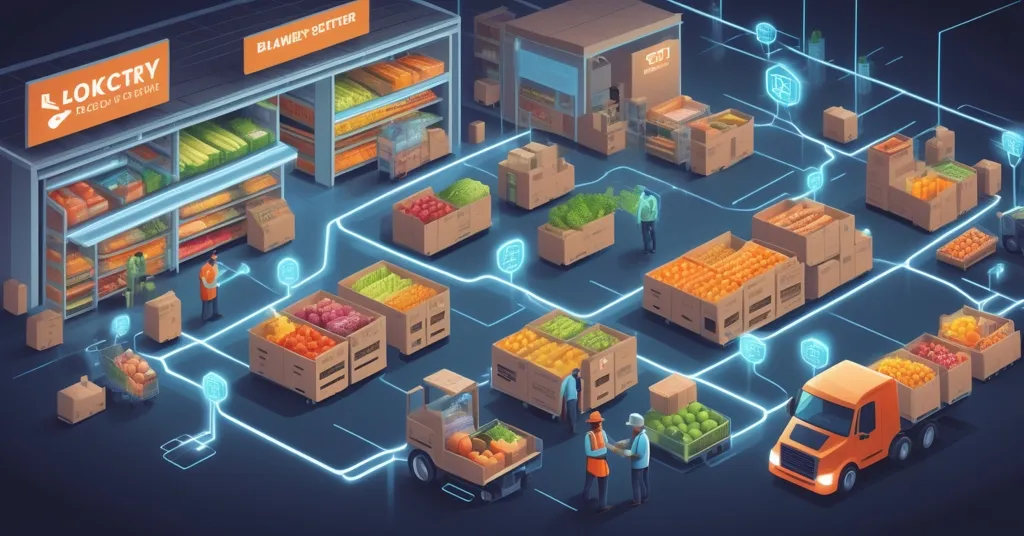Blockchain vs. Food Fraud: Can It Revolutionize Supply Chains or Is It Just Hype?

Blockchain on the Menu: Can It Stop Food Fraud and Transform Our Supply Chains?
Food fraud is a global menace, siphoning off $50 billion annually from the food industry while risking lives with tainted or fake products. Blockchain technology, the decentralized force that powers Bitcoin, is being touted as a revolutionary fix to bring transparency and trust to our food supply chains. Yet, the path to implementation is a minefield of costs, tech glitches, and regulatory chaos. Let’s dig into whether this tech can truly end food lies or if it’s just another overhyped promise.
- Food Fraud’s Toll: Costs the industry $50 billion yearly and endangers consumer health.
- Blockchain’s Edge: Offers tamper-proof tracking, cutting traceability times to seconds.
- Major Obstacles: High costs, technical issues, and fragmented regulations stand in the way.
The Ugly Reality of Food Fraud
Food fraud isn’t just about shelling out extra for olive oil that’s been cut with cheap filler—it’s a sinister problem that’s taken lives and shattered confidence in what lands on our plates. Consider the 2008 milk scandal in China, where melamine, a toxic chemical, was mixed into baby formula, sickening over 300,000 infants and killing six. That’s not a one-off nightmare; it’s a glaring example of how murky supply chains give fraudsters free rein. The economic damage—$50 billion each year—matches the GDP of a small nation like Malta, despite being a sliver of the $12 trillion global food market. This isn’t petty crime; it’s a direct threat to safety and trust.
For those new to the term, food fraud is the deliberate deception about a product’s quality or contents for profit. Think mislabeling fish species, diluting honey with sugar syrup, or passing off horsemeat as beef. It thrives in complex, global supply chains where oversight is spotty and records are easy to fudge. The stakes couldn’t be higher—beyond financial loss, it’s about whether we can trust the food we feed our families. For a deeper dive into how this tech could help, check out some community discussions on blockchain solutions for tackling food fraud.
Blockchain’s Promise: Transparency from Farm to Fork
Blockchain, the tech that made Bitcoin a middle-finger to centralized banking, is now pitched as a solution to this mess. At its core, it’s a decentralized ledger—a digital record spread across many computers, where every entry is locked in and nearly impossible to alter. In food supply chains, this means logging a product’s entire journey, from the farm where it’s grown to the fork on your table, with full transparency. Every harvest, shipment, and storage step is recorded in a way that’s visible to authorized parties, making fraud harder to pull off. To understand the basics of this technology, you can explore more on blockchain technology in supply chains.
Walmart, a titan in retail, has put this to the test using Hyperledger Fabric, a blockchain platform designed for enterprise use. They’ve slashed tracking times for items like pork in China and mangoes in the US from days to mere seconds—down to 2.2 seconds in some instances. This isn’t just a cool stat; it’s a game-changer for crises like contamination outbreaks, allowing tainted goods to be identified and pulled before they harm more people. Learn more about their implementation in the Walmart blockchain traceability study. Frank Yiannas, former VP of Food Safety at Walmart, summed up the shift in perspective:
Blockchain’s decentralized ledger is ideal for food systems… it can save lives and protect farmers by enabling precise recalls during outbreaks.
Karl Bedwell from Walmart Technology reinforced this, noting Hyperledger’s emphasis on trust and controlled access makes it a better fit for traceability than public blockchains like Ethereum, which prioritize openness over enterprise security.
Testing the Waters: Pilots and Policy Moves
The momentum isn’t limited to Walmart. Companies like TE-Food and Provenance are running pilot programs with farmers, distributors, and retailers to see if blockchain can handle the chaos of real-world supply chains. These aren’t mere tech stunts; they’re critical experiments to prove the concept. For the latest on these initiatives, take a look at updates on TE-Food and Provenance pilot projects. On the regulatory front, the European Union is paving the way with laws like EU 178/2002, which requires tracking food origins—a perfect match for blockchain’s digital logs. Dr. Sylvain Charlebois of Dalhousie University’s AgriFood Analytics Lab calls the EU a benchmark, suggesting their framework could inspire global standards if others catch up. More on these policies can be found in discussions about EU and Asia regulations on food traceability.
Some Asian governments are also eyeing clearer traceability rules, signaling a slow but growing push toward adoption. These steps matter because without a legal backbone, tech solutions risk being sidelined as novelties rather than necessities.
Not Just Bitcoin: Altcoins and Specialized Solutions
As Bitcoin maximalists, we’ll always champion the OG of decentralization, but let’s give credit where it’s due—other blockchains and altcoins are carving out vital roles in this space. Ethereum’s smart contracts, for instance, are self-executing agreements coded onto the blockchain that can automate supply chain processes, like releasing payment to a farmer only when goods pass quality checks. VeChain, a lesser-known player, focuses specifically on logistics, offering tools tailored for tracking food and luxury goods with consumer-friendly QR codes. These platforms fill niches Bitcoin wasn’t built for, advancing the decentralized ethos into practical, everyday applications. It’s not about replacing Bitcoin’s vision; it’s about complementing the broader financial and systemic revolution.
The Hard Truth: Why Blockchain Isn’t a Magic Fix
Before we start dreaming of a fraud-free food utopia, let’s slam the brakes hard. The barriers to blockchain adoption are brutal, and anyone peddling this as an easy win is full of it. First, the cost—rolling out a large-scale blockchain system can run into millions for software, hardware, and staff training. That’s chump change for a Walmart, but a death knell for smaller farms or distributors already scraping by. If you’re curious about specific mechanisms, explore insights on how blockchain prevents food fraud.
Then there’s the tech itself. Blockchain can’t fix lousy data. If a sensor tracking a shipment malfunctions or an “oracle”—basically an external data feed into the system—gets hacked, the so-called tamper-proof ledger is just a polished lie. Cold-chain tracking is another blind spot; it ensures perishables like meat or dairy stay at safe temperatures during transport to prevent spoilage. Blockchain doesn’t monitor fridges—it relies on separate devices that can fail or be manipulated, leaving gaps in the chain.
Human and Regulatory Nightmares
Tech aside, the human factor is a mess. The food industry is a cutthroat arena—farmers, shippers, and retailers guard their data like dragons hoarding gold. Getting them to collaborate on a shared blockchain, even with anonymized info, is like convincing a pack of wolves to split a steak. And regulations? They’re a global cluster of confusion. While the EU sets a high bar, standards vary wildly elsewhere, making cross-border supply chains a logistical hellscape. David Carvalho of Naoris Protocol hit the nail on the head: fragmented data systems are fraud’s best friend, and blockchain’s visibility could crush that—if we ever untangle the bureaucratic knot.
Even the enthusiasts throw shade. Temujin Louie of Wanchain pointed out that despite over a decade of blockchain hype since Ethereum’s debut, supply chains remain largely untouched. Early, half-assed attempts crashed and burned, and without focused, pragmatic strategies, we’re just chasing our tails. It’s a harsh reality check: shiny tech means nothing without the grit to make it work. For a broader perspective, see the impact of blockchain on supply chain transparency.
Momentum Building: From Experiments to Action
Still, there’s reason to stay cautiously hyped. Walmart isn’t resting on pilot laurels—they’ve mandated suppliers of fresh leafy greens to adopt Hyperledger Fabric after the 2018 E. coli outbreak with romaine lettuce exposed the flaws of traditional tracking. This isn’t a sandbox anymore; it’s a real-world rollout showing blockchain can scale when the big players commit. Pair that with supporting tools like IoT—smart sensors tracking a shipment’s temp in real-time—or AI sniffing out fraud patterns, and you’ve got a serious kit. It’s not a lone silver bullet; it’s an evolving arsenal.
Rebuilding Trust: A Consumer Win or Empty Gimmick?
The ultimate prize is consumer trust. Fraud doesn’t just sting wallets; it screws honest businesses and leaves us all second-guessing every bite. Blockchain could flip that script with public, auditable records—imagine scanning a QR code on your salmon to see its path from ocean to store. It’s decentralization at its finest, slashing out shady middlemen and empowering the end-user, much like Bitcoin did for finance. But let’s not get carried away: will the average shopper really bother with a QR scan? Is this a transformative feature or a niche trick oversold to justify the price tag? That’s a debate we need to chew on. For more on this potential, read about blockchain’s role in revolutionizing food transparency.
The Dark Corners: Risks We Can’t Ignore
We’d be remiss not to spotlight the shadows. Blockchain’s transparency cuts both ways—supply chain data, if not properly anonymized, could leak sensitive business intel or be weaponized by rivals. Energy consumption, a frequent critique of systems like Bitcoin’s mining, also haunts some blockchain setups for supply chains. And here’s a devil’s advocate jab: couldn’t simpler, centralized databases with tight audits do the job in some cases without the tech baggage? It’s a tough pill for decentralization diehards like us, but ignoring it would be intellectual cowardice.
Key Takeaways and Burning Questions
- What is food fraud, and why is it such a big deal?
Food fraud is the intentional deception about food quality or contents for profit, draining $50 billion yearly from the industry and risking lives, as seen in the 2008 China milk scandal impacting over 300,000 infants. It’s critical because it undermines the safety and trust we rely on daily. - How does blockchain fight food fraud in supply chains?
Blockchain creates an unalterable, transparent record of a product’s journey from farm to fork, slashing traceability times to seconds, as Walmart demonstrates. This openness makes fraud tougher by spotlighting discrepancies fast, if the setup holds. - What’s blocking blockchain from widespread use in food tracking?
Crippling costs in the millions, tech flaws like unreliable data inputs, industry hesitance to share data, and inconsistent global regulations stall progress. It’s a complex web of players that’s damn hard to sync up. - Are we seeing real progress, or is this all hype?
Progress is tangible—Walmart’s supplier mandates, pilots by TE-Food, and EU regulatory leadership show movement. But keep the champagne corked; cost and logistical walls mean it’s not a full-on win yet. - Can blockchain alone wipe out food fraud?
Hell no. It’s a strong tool for transparency, but needs solid data, legal support, and extras like IoT sensors to deliver. Hyping it as a cure-all ignores the ugly reality of rollout and entrenched fraud incentives. - What role do altcoins play in this food supply revolution?
Beyond Bitcoin, Ethereum’s smart contracts and VeChain’s logistics focus bring specialized tools for tracking and automation. They tackle practical gaps, extending decentralization’s reach in ways Bitcoin doesn’t directly target. - What hidden risks does blockchain bring to food chains?
Privacy issues loom if data isn’t anonymized, potentially exposing trade secrets. Energy use critiques mirror Bitcoin mining flak, and there’s a valid question if centralized systems might sometimes be leaner—a bitter but real counterpoint.
The Future: Acceleration or Dead End?
So, what’s the verdict? Blockchain’s potential to gut-punch food fraud is clear—quicker recalls, safer families, and a loud screw-you to scammers lurking in shadowy supply chains. It embodies the effective accelerationism we root for: tech sparking real change, not just speculative froth. But the road ahead is a slog, paved with financial traps, tech hiccups, and red tape thicker than a banker’s playbook. If we’re dead-set on ending food lies, it’ll take more than clever code—it’ll need collaboration, cash, and the balls to tear down the status quo. Bitcoin showed us centralized money could be disrupted; now let’s see if blockchain can pull the same stunt for the trust we put in our plates. If it does, we’re not just eating better—we’re savoring the flavor of decentralization.



